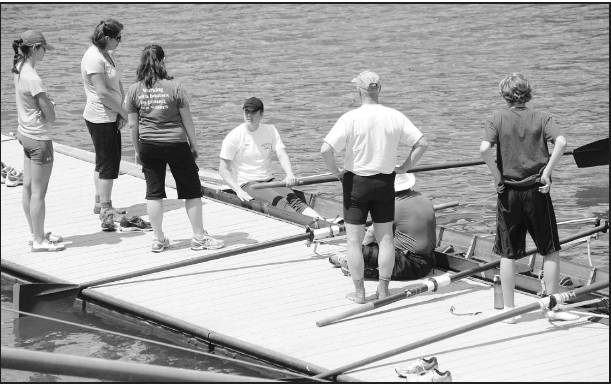Learn to Row Day a Hit on Mon River
Morgantown Dominion Post
3 June 2012
By Jack Lake
The Monongahela Rowing Association (MRA) took full advantage of
the nice weather Saturday on National Learn to Row Day.
Rowers from the MRA and WVU women’s rowing team came together to
promote the sport to area residents.

“The intent of this event is to publicize the sport of rowing, the
availability in Morgantown and to get more people out to
participate and see that it is a great sport,” former MRA
president John Duarte said. “The sport has a place in Morgantown.
We’ve got a great river, and I think there is room to do a lot
more.”
Upon arrival, visitors entered the boat house, where they were
briefed on boating and water safety. After the short video, basic
technique was demonstrated before visitors headed off to the
docks.
“I think it was set up very nicely,” WVU sophomore Emily Phipps
said. “I think it was great to have people from the university and
the MRA here to help train us.”
Instruction continued as visitors climbed into one of three
training boats and received coaching from MRA members. The amateur
rowers paddled back and forth from the docks. MRA members gave
advice on posture, turning and technique while holding on to ropes
attached to the boats, ensuring no one would float down river
unprepared.
After being deemed ready to row solo, some visitors were untied
and sent out to explore the river by the power of their own bodies
where they could row either in a one-man or four-man boat.
“I grew up in North Carolina on a lake and always kayaked before
and loved being on the water,” Phipps said. “I wanted to see if
rowing was anything like it and it’s definitely not, but I
definitely think it’s a great sport.”
There are some misconceptions about the sport of rowing, who can
participate and what it takes to be a rower.
“People look at rowing and think it’s an upper-body sport but it’s
not,” MRA President David Rosend said. “It’s really a lower-body
sport.”
Though most of the work in rowing is done with the legs, the sport
is praised by most MRA members as a fullbody workout of the legs,
core, arms and back. Rosend even suggests rowing as great training
for triathletes. Rowing is a low-impact sport, making it great for
those who might not be able to participate in other sports due to
joint problems or injury.
After a cycling accident that left Duarte with a broken pelvis
three years ago, his participation in other sports such as running
and cycling has been limited, though he is still out and rowing
due to its low-impact nature.
The adaptability of the sport is something that only makes it more
accessible to more people. Rosend has been involved with the sport
for more than 40 years despite the fact that he has been in leg
braces since before his teens.
Rosend was stricken with polio at age 11 and struggled to find his
place in sports. After trying several sports, Rosend came upon
rowing and everything was downstream from there.
“There was nothing I couldn’t do with rowing, finally I had a
sport I could do and do well,” Rosend said. “I was fortunate
enough my school had boats ... Once I’m on the water, I can row as
well as anybody.”
Rosend said there are many adaptive rowing opportunities for those
with disabilities, such as blindness and even missing limbs.
